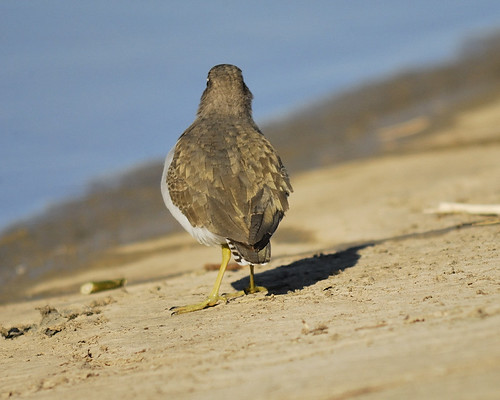tags: Spotted Sandpiper, Actitis macularia, birds, mystery bird, bird ID quiz
[Mystery bird] Spotted Sandpiper, Actitis macularia, photographed at the Arthur Storey Park, Houston, Texas. [I will identify this bird for you in 48 hours]
Image: Joseph Kennedy, 28 December 2009 [larger view].
Nikon D200, Kowa 883 telescope with TSN-PZ camera eyepiece 1/640s f/8.0 at 1000.0mm iso400.
Please name at least one field mark that supports your identification.
More like this
This is a summary of several of the better books I’ve had the opportunity to review here, organized in general categories.
tags: birds, mystery bird, bird ID quiz
tags: conservation, endangered species,
Family Guy, S07E02 'I Dream of Jesus':
Peter: Brian, can I see that paper for a sec?
(Brian gives Peter the paper. Peter peruses the paper.)
Peter: Huh... that's odd... I thought that would big news.


Neat shot. The longish, strong legs and the beach setting suggest shorebirds, and the hallux (rear toe) rules out all of the smaller plovers. So, we're left with sandpipers. There's some barring in the wing coverts, and we can see a bit of the tail pattern.
But I think I'll leave it at that for now.
and I think the lack of white spots on the back eliminate a very "lonely" relative, and the relatively light-colored legs should eliminate it's Eurasian sister which may visit from time to time... range excludes that West Coast "gossip", so I think we are left with some "immacualte speckling" (only one word of which is the appropriate Latin!)
Spot on, David.
LOL at me:
"only one word of which is the appropriate Latin" = "only one word of which is actually spelled correctly in English!"
Did we scare everyone off with that dread word 'sandpiper'? Turns out that here in N.Am. the tail pattern alone is enough to reduce this to three possibilities.
Weekends tend to be slow Paul, and when I'm not off gallavanting on some conservation or garden project, this is the only time I actually get to see the photos when they are posted...
Perhaps the word "sandpiper" does bring to mind the trauma of sorting out the difference between Short= or Long-billed Dowitchers, Sharp-tailed or pectoral Sandpipers, or my toughest challenge, Semipalmated or Western Sandpipers...
in this case, the combination of leg length and color, plumage color and [lack of] marking on the back, what I see as the end of a white eyestripe, and the barring on the tail reduced it very quickly to what I beleve is the only answer...
eliminated is the "lonely relative", the Solitary Sandpiper (Tringa solitaria) because of the lack of white spotting on the back (and which would not have a white eyestripe); eliminated also is it's "Eurasian sister" the Common Sandpiper (Actitis hypoleucos), which is listed as a rare visitor but which would have darker legs; eliminated also, because of range and also the barring pattern on the tail is the "West Coast gossip", the Wandering Tattler (Heteroscelus incanus); both yellowlegs species, Tringa melanoleuca and T. flavipes would have much longer legs...
so we should be left with Actitis macularia, the ubiquitous specific meaning "speckled": the Spotted Sandpiper?
Guess you're right about weekends, David. I came up with Spotted as well, based on the tail pattern, the barring visible in the flight feathers, the lack of spotting (ergo no Solitary), and the relatively short tail and lack of distinct barred edges on the tertials (this combination rules out Common Sandpiper). Yellowlegs, Marsh Sandpiper etc. might show barred outer tail feathers, but would also show barred central tail feathers.
I hadn't realized Common Sandpiper shows darker legs -- of course, the only reference I have up here that shows Common is NatGeo.
Hey Paul, I found this a good reference guide to the close-up nuances of Common Sandpiper field marks from an online guide, Atlas de Identificación de las Aves de Aragón by Javier Blasco Zumeta, a bird-ringer and teacher from Spain.